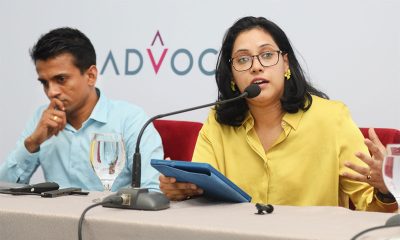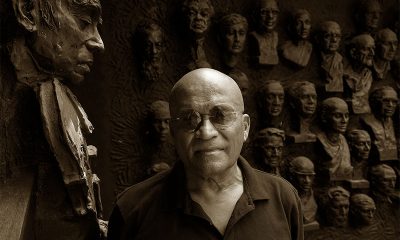Opinion
Alternative Medicine for COVID-19

A reply to letter by Prof. Rohini Fernandopulle
I wish to bring the following facts for your kind attention. In August 2020, for the first time in history, the State Ministry of Pharmaceutical Production, Supply & Regulation was established in Sri Lanka. I believe this was a progressive step to develop the pharmaceutical industry in Sri Lanka. Subsequently, as the State Minister of Pharmaceutical Production, Supply and Regulation, I have inaugurated and implemented many activities to promote local production, and distribution of pharmaceuticals, and also to strengthen the regulatory framework.
I am yet to receive a word of appreciation from the Sri Lanka Association of Clinical Pharmacology & Therapeutics (SLACPT). This deafening silence can be attributed to the fact that some of your membership does not approve the decisions made to blacklist and bar the politically motivated corrupt businesses that had infested the local market. I am well aware that some members had maintained a very close relationship with those business entities.
It is interesting to note that the Facebook page of SLACPT that was inactive for several months, who had not contributed by word or deed during the COVID-19 pandemic and the last post was on 16th March 2020, has suddenly awakened, published and propagated misinformation on 1st November 2020.
Also, I was informed that several members of SLACPT are instigating other organizations, newspapers and websites to publish the misinformation. Some members of your association embarked on vilifying and discrediting me, and the Government of Sri Lanka.
I would like to state that a team of professional and credible academics including Dr Saroja Weerakoon & Prof. Kamal Perera (Institute of Indigenous Medicine, University of Colombo), Prof. Dulani Gunasekara (Pediatrician, University of Sri Jayewardenepura) and Prof. T S Suresh (Department of Biochemistry, University of Sri Jayewardenepura) had researched “Sudarshana Syrup”. I was not a part of this research group or the study. I along with the Hon. State Minister Sisira Jayakodi, Secretary to the Ministry & the Director of the IDH hospital met with this team at my office. When requested, I undertook to facilitate a Randomized Controlled Trial (RCT) in the State Sector. Thereafter, I directed the director of the IDH hospital to discuss the possibility of conducting the RCT, with the consultants attached to IDH.
During this meeting, I categorically emphasized the procedure to be followed before the syrup can be prescribed by the allopathic doctors. However, if the drug is in the Ayurveda pharmacopoeia, there will be no restrictions for Ayurveda practitioners to prescribe the said drug. Hence, it is an unnecessary request to “reconsider the decision to recommend the use of this drug” because this decision was not taken. Per my knowledge, this drug is still not produced commercially; therefore there was no point to worry Prof. Fernandopulle, concerning “increase of the sale”
I feel this letter is unprofessional and is motivated by a third party. I would like to know if all the listed office bearers and the council members are aware that this letter has been directed to me or is this just the personal opinion of Prof. Fernandopulle. If she had a concern about the publications on media and social media on “Sudarshana Syrup”, as a professional, I would expect her to clear the issues with me before publishing such a biased, unfair and destructive letter, based on nothing but distorted and misquoted facts. Further, SLACPT would contact Prof Asita de Silva, President elect of their association for an elucidation. He is the chairman of NMRA, which is under my purview, hence we regularly meet for official matters.
I earnestly request SLACPT to creatively and constructively contribute to the new program to create a self-sufficient nation with pharmaceuticals and the mission of controlling COVID-19, rather than issuing destructive and misleading letters.
CHANNA JAYASUMANA
State minister
Opinion
Dr A. T. Ariyaratne: A human being of iconic opulence
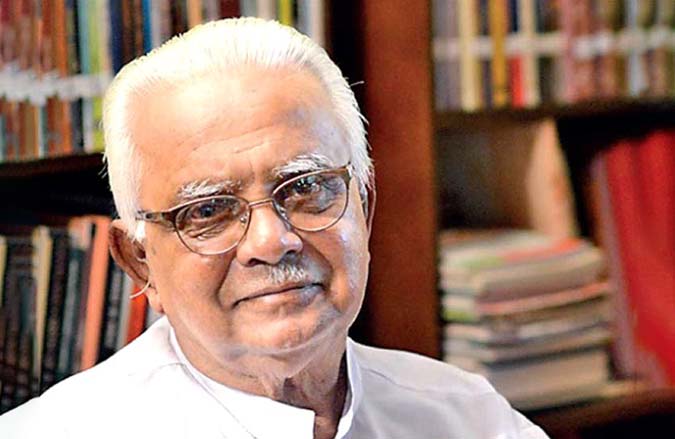
by Dr B. J. C. Perera
In the gigantic tapestry of humanity, there are those rare individuals who emerge as beacons of light, illuminating the path for others, with their wisdom, compassion, and altruism. Dr A. T. Ariyaratne, the esteemed Founder of the Sarvodaya Movement of Sri Lanka, was undeniably one such luminary; a man whose life was an extraordinary testament to the power of love, service, and spiritual awakening.
As we say goodbye to this great son of the soil, amidst the gentle whispers of intense sorrow and the resounding echoes of gratitude, we do honour the profound legacy of Dr Ariyaratne. He is a man like no other, whose very existence transcended the boundaries of time and space, leaving an indelible mark on the very fabric of reality. He was not just a mere person; he was a massive guiding force, and a source of inspiration for countless individuals across Sri Lanka and beyond. His passing leaves a void that cannot be filled, but his legacy will continue to shine brightly, enlightening the track for generations to come.
To speak of Dr Ariyaratne is to delve into the depths of human potential, to explore the boundless possibilities that arise when one has to talk about one who dared to dream, to envision, and to act with unwavering faith and conviction. His journey, though rooted in the soil of Sri Lanka, traversed the realms of the human spirit, touching hearts and igniting souls, right across the globe.
Dr Ariyaratne was more than just the founder of the Sarvodaya Movement; he was the very essence of its heart and soul. With unwavering dedication and boundless compassion, he dedicated his life to serving others, tirelessly working towards the betterment of society. His vision of a peaceful and harmonious world, built on the principles of love, compassion, and generosity, resonated deeply with people from all walks of life. Through his actions and teachings, he touched the lives of millions, instilling hope, fostering unity, and empowering communities to create positive change.
What set Dr. Ariyaratne apart was not just his extraordinary accomplishments, but the profound kindness and humility with which he carried himself. Despite his immense influence and stature, he remained humble and approachable, treating everyone he met with respect and dignity. He had that rare ability to connect with people on a personal level, listening with empathy, offering words of wisdom, and of course, inspiring them to believe in themselves.
At the heart of Dr Ariyaratne’s remarkable odyssey on Planet Earth lay the Sarvodaya Movement, which showed up as a profound manifestation of his vision for a world where every individual, regardless of creed, caste, or colour, could awaken to their inherent spirituality as well as potential, and contribute to the collective embroidery of peace and harmony. With a steadfast commitment to the Gandhian principles of non-violence, self-reliance, and community empowerment, he pioneered a path of transformation that transcended the limitations of the material realm and embraced the infinite potential of the human soul. In the words of the poet Rumi, “The beauty you see in me is a reflection of you.” Dr Ariyaratne’s life was a testament to the inherent beauty and divinity that resides within each and every one of us; a reminder that we are not merely separate beings, but interconnected threads in the rich drapery of existence.
Yet for all that, Dr. Ariyaratne’s impact extended far beyond the mere establishment of an organization. It permeated the very essence of human consciousness, awakening hearts to the inherent interconnectedness of all beings and inspiring a profound shift in perspective: one rooted in love, compassion, and reverence for all life.
But perhaps, amidst the splendour of his accomplishments and the profundity of his teachings, it is Dr Ariyaratne’s heart as a human being, a vessel of boundless love and compassion, that truly set him apart from lesser mortals. In his presence, one could not help but feel the gentle embrace of universal love, the soothing balm of empathy, and the radiant glow of inner peace.
For Dr Ariyaratne was not merely a leader or a visionary; he was a friend, a mentor, and a beacon of hope for all who crossed his path. With humility as his armour and kindness as his weapon, he embarked on a sacred mission to uplift humanity, perhaps even one at a time, and in doing so, he touched the lives of countless souls, leaving behind a legacy of love and transformation that shall endure for eternity.
In the hallowed halls of history, Dr. Ariyaratne’s name shall forever be inscribed as a paragon of virtue, a beacon of hope, and a guiding light for generations to come. His teachings, imbued with profound wisdom and illuminated by the radiance of his spirit, shall continue to echo through the corridors of time, inspiring souls to awaken to their true potential and embark on the sacred journey of self-discovery and service.
As we bid farewell to this earthly form of Dr Ariyaratne, let us not mourn his passing, but celebrate the profound gift of his presence in our lives. Let us honour his memory by embodying the principles of love, compassion, and service that he so tirelessly espoused, and by carrying forward the flame of his spirit into the darkest corners of the world, illuminating the path for all who seek solace and guidance.
In the words of Mahatma Gandhi, whom Dr. Ariyaratne greatly admired, “The best way to find yourself is to lose yourself in the service of others.” Dr Ariyaratne personified and exemplified this philosophy in everything he did, and his life stands as a testament to the power of compassion, empathy, and selflessness. Let us honour his memory by carrying forward his legacy, spreading love and kindness wherever we go, and working tirelessly towards the realization of his vision of a better world for all. Dr A. T. Ariyaratne may have left this world, but the dazzling light of his wonderful life will continue to shine brightly, guiding us towards a brighter future for generations to come.
Opinion
Dr A. T. Ariyaratne, the most important person for all time
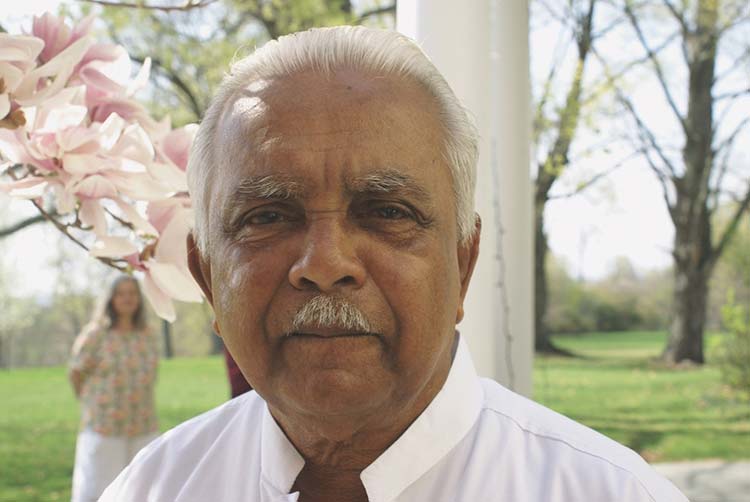
Appreciation:
by Jehan Perera
The government’s decision to conduct the funeral of Dr A T Ariyaratne with state honours is a recognition of the contribution that the founder of the Sarvodaya Movement made to the country over the past 65 years when he set up the organization. Concepts he pioneered such as Shramadana (donation of labour), Gramodaya (village awakening) and Sarvodaya (the wellbeing of all) are today part and parcel of the mainstream of Sri Lanka’s civil and political life. His creative use of traditional practices and belief systems enabled the Sarvodaya Movement to become an organic part of the country’s development process. The great contribution that Dr Ariyaratne made was to mainstream not only traditional community-oriented practices like Shramadana, but also to infuse liberal values such as pluralism and equality into civil society that enabled its spread to the four corners of the country.
Dr Ariyaratne infused the Sinhala-Buddhist culture, from where his thought and work started, as a teacher in one of Colombo’s premier Buddhist schools, Nalanda College, with values of sharing and mutual respect that reached out to other communitie in a society wracked by religious, ethnic, caste and class divisions. The Sarvodaya Movement under his leadership became a magnet for young people who wanted to contribute to the upliftment of their societies.
Many of the leaders of civil society organisations today had their period of initiation at the side of Dr Ariyaratne, who was called Loku Sir. I was one of those who worked with him and was influenced by his thinking. Three concepts he believed in are of perennial importance. First, that development needs to be for the wellbeing of all, not the wellbeing of the majority or of a minority. Second, that development is not only about economic development, but also about social, cultural, moral, spiritual and political development. Third, to ensure development from below, by decentralising power and resources to the lowest level possible, which to him was the village community.
Dr Ariyaratne was the quintessential civil society leader, not wielding state or political power, but the power that comes from ideas and the ability to demonstrate what is possible at the micro level so that the state could replicate it at the macro level. Today, there is no place that the Sarvodaya Movement has not touched in the form of a development-oriented activity or the presence of a community worker who has not gone through at least one of its trainings. In the depths of today’s despair and economic collapse, we can only imagine the difference if even one of Sri Lanka’s many governments over the past 65 years had entrusted its national development programme to this visionary leader.
He once related to me a story to illuminate the priorities one should have in life. It was drawn from the great Russian novelist Tolstoy. The story was about a king who wanted the answer to three questions—what is the most important time in a person’s life? Who is the most important person? What is the most important thing to do? Wise (and not-so-wise) persons he questioned gave many and varied answers. Some said the time of birth (astrology), the father or mother, earning well, as their answers to these three questions. Tolstoy’s answer, which met with Dr Ariyaratne’s approval was—the most important time is now, the most important person is the person you are with now, and the most important thing to do is to love and serve that person. When Dr Ariyaratne engaged with undivided attention with those he was with (including myself) and held their hands as he spoke looking at their faces, he lived this story.
This poem is dedicated to Dr Ariyaratne by one whose life he touched ever so gently and kindly.
‘Tis a season of life
Of celebration
Of remembering
Of introspection,
examination
and reevaluation
For the living.
‘Tis moments relived
Lessons relearnt
Love remembered.
A passing
Is not the end
But a pause
To find meaning
In our own existence,
The infinite merges
Into the now.
–by Sumadhu Weerawarne Perera
Opinion
What is Jathika Chinthanaya?
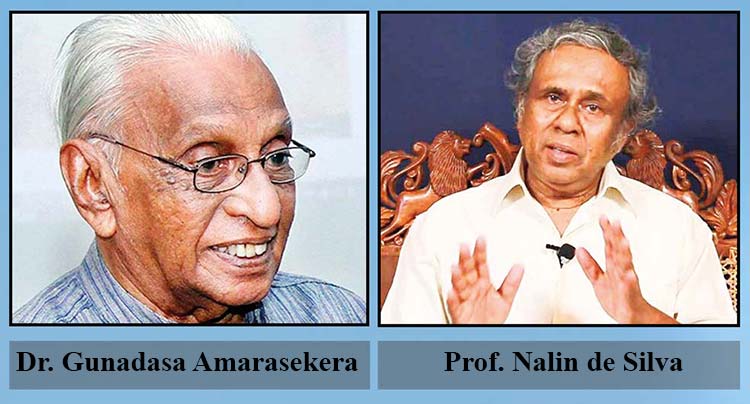
A response to the ‘Anatomy of a movement: Jathika Chinthanaya’
by Dr. Sumedha S. Amarasekara
This article is a response to the question- ‘If the failure of the left was what portended Jathika Chinthanaya, what would the sterility and decay of Jathika Chinthanaya portend?’ asked by Uditha Devapriya (UD) at the end of his article: ‘Anatomy of a movement: Jathika Chinthanaya’ (The Island 15.03.2024).
In his article, UD analyses the reasons for the failure of the Left and the fallout from it. Though he is unable to specifically tie in the ‘demise of the Left’ with the ‘relevance of Jathika Chinthanaya (JC), he maintains this to be the case, more or less on the lines that nature abhors a vacuum. Despite the title, UD does not seem to discuss the anatomy of JC, and in the absence of this, it is difficult to ascertain what UD means by ‘the JC of today is no longer the JC of yesterday’. UD instinctively sees a connection between the introduction of an open economy and the aftermath that followed, and the relevance of JC. However, UD does not seem to have been able to corelate these separate concepts meaningfully, especially in the absence of a meaningful ‘definition’ of JC.
In order to answer UD’s question, one must understand the concept of JC and then look at the Left movement in this country from that perspective, it is only then that a sensible answer can be arrived at.
JC can be best described as an ideology based on a ‘civilisational consciousness’ that we have acquired over the last two and a half thousand years. According to Anagarika Dharmapala people of this country guided by this civilisational consciousness lived ‘a contended life’. Each family had a plot of land and the forest and the grasslands were open to the public for their use. The people followed the Sangha who lived a collective life. Collectivism, and not individualism, was the aim of their existence.
Our kings who ruled our country were not tyrants or despots (in a general sense, though a few of them may have been). They were guided by an ethical code – Dasa Raja Dharma, the political /economic system that had evolved over centuries guided by a civilisational consciousness; the Buddhist ‘way of living’ that we had right up until the time we came under the dominion of the British in 1815. What is critical to grasp is that even throughout the rule of the British this ‘civilisational consciousness’ remained intact throughout the villages of this country. It is this civilisational consciousness that was flourishing in the village life that is depicted in the novels by Martin Wickremasinghe (MW) and Gunadasa Amarasekera (GA). In fact, one could argue that MW is the one who started the dialogue of JC, albeit at a subconscious level.
What happened between 1815 and our Independence in 1948, changing the destiny of our country (any many other countries) was the Industrial Revolution. To appreciate the recent (during the last 200 years) economic/political changes in the world, it is pertinent to understand that despite a myriad of scientific advances and break throughs, right up until the industrial revolution there were no real changes in the day to day living.
For example, Julius Cesare arrived in Alexandria, Egypt in 48 BC riding in a ‘horse driven vehicle’ and 2000 years later Abraham Lincoln came to the White house in 1860 still in a ‘horse driven vehicle’. The industrial revolution changed all of this in an unprecedented manner and speed. The industrial revolution-starting in the 19th century- leading to a capitalistic society swept across the world and its propagation happened in this country according to the wishes of our colonial masters, the British- their ideology, expectations and beliefs.
The traditional Left movement in Sri Lanka coincided with the development of the Left movements in the rest of the world- which were an alternative response to the ‘capitalistic society’ which followed the industrial revolution and the increasing ownership of private wealth. Central to these movements was the ideology expounded by Karl Marx (1818- 1883) who saw a socialist state as the next stage in the economic development where workers would own the production process (and benefits) which would lead to the eventual abolition of private property. It was this anti-capitalistic sentiment in the Left movement which resonated in both Gunadasa Amarasekera (GA) and Prof. Nalin de Silva (NdS), which is the explanation as to why both of them were sympathetic towards a Left cause.
In 1948 when we were granted independence; the United National Party (UNP) which came into power, was the de-facto ‘British party’ carrying out the economic policies for a capitalistic society with the Left political parties lined up against this. It was SWRD Bandaranaike who made the first conscious step away from this capitalistic model forming the Sri Lanka Freedom Party (SLFP) in search of our own model. If Anagarika Dharmapala’s movement is considered as a national awaking of the JC, the SLFP could be considered as the beginning of a political party representing the JC.
The 1970 ‘s government under Mrs. Srimavo Bandaranaike (United Front coalition with the Left movement) was a further step away from the capitalistic direction. Despite the criticisms levelled at her government, it was the first and last time that we, as a nation achieved true economic independence under the guidance of Dr. N.M. Perera as the Minister of Finance and probably had the best foreign policy we ever had-the non-aligned policy.
In 1977, under the auspices of JR Jayewardene, our country embraced an open economic policy in a diametrically opposite path, to what had been taken up to that time. The economic path was Right centred to such an extent that the traditional Left movements became obsolete. As UD states in his article it was the open economic policies of the UNP government that paved the way for the terrorist movements in the South by the JVP and the North by the LTTE. It was a country plunging into disarray that triggered the buried ‘civilizational consciousness ‘of GA in search of our JC.
This search preceded the events in 1977. The splintering of the coalition in 1975, changed the then existing political climate and it looked as if we were leaning again towards a capitalistic path- if not lost our way. It was this feeling of impending gloom and doom that pushed GA to write ‘Abuddassa yugayak’ in 1976. This was the start of his journey towards JC.
‘Anagarika Dharmapala Marxwadida’?
which came out in 1980 embraces the ideological dialogue that GA has with the Left movement/Marxism and JC. This book is probably the most significant political analysis /review that has been done with regard to the role played by Anagarika Dharmapala and provides the deeper understanding to the political movement initiated by SWRD Bandaranaike. ‘Ganaduru mediyama dakinemi arunalu’ published 10 years after the ‘1977 – dharmishta society’ signifies the completion of GA’s study of JC. It was during this time that NdS also seemed to have moved away from his Left leanings.
At that time GA saw the Janatha Vimukthi Peramuna (JVP) as an umbrella group that consisted of the educated youth of this country who were unhappy with the current politics of this country. In Ganaduru mediyama dakinemi arunalu GA discusses the ideological clashes between JC and the traditional Left/ Marxist movement in great detail and as to why they failed in this country. Ganaduru mediyama dakinemi arunalu was in fact, an invitation for this group to embrace their heritage of JC and start a new path. It is probably the concept of JC that influenced politicians such as Wimal Weerawansa who were originally with the JVP to lean away from the Left /Marxist views towards nationalism.
The mid to late 1980’s can be described as a time where there was a huge debate raging throughout the country on civilisation and civilisational consciousness. This was partly due to the opposition by the Tamil separatists (militant and otherwise) and foreign powers who were out to divide this country and the NGOs that funded them. They opposed JC on two fronts, working towards this common goal of a divided Sri Lanka. One front argued that we were all part of humanity and that in reality there was no such thing as an ethnic/national identity!
The other front took the pendulum to the other end and portrayed JC as based on the ethnic consciousness of the Sinhala people and that it is a ‘Sinhala Jathika Chinthanaya’ – an ethnic nationalism based on an ethnic consciousness. GA pointed out the inherent contradiction in the term ethnic nationalism and maintained that ethnic consciousness based on culture cannot take the place of civilisational consciousness based on the harmonious co-existence of different ‘ethnic consciousnesses’ and cultures. This is what we had prior to the advent of the foreigner. There were no clashes among the ethnic groups – no fighting among them. The fights were with the invaders.
GA and NdS had to fight hard against this misconception promoted by the NGOs. It was during this period, as a medical student, that I had the privilege of being exposed to the brilliant oratory of Prof. NdS, who was then at the Department of Mathematics of the University of Colombo. Being born in 1993, UD as well as almost all of our younger generation, unfortunately would have missed these brilliant arguments given in the style of Nagasena Wasthuwa.
The issue of a national identity had an enormous impact on the country and especially the army that was fighting the war. True the army was fighting against the LTTE, but what were they fighting for? One fights for one’s family or one’s country: and here was a situation where the people as well as the world outside were made to believe that we fighting the Tamils and this was an ethnic war.
GA, NdS as well as many other national movements worked tirelessly during this period to counteract this vicious propaganda and create a sense of nationalism. It was especially in this context that the Left movements proved to be impotent. The Left movements identified only with class. They had no inherent national identity. How does a movement that does not identify with the concept of a nation support a national cause? JC was the ideology that provided the answer to this question.
The JVP movement despite being a ‘homegrown movement’ did not appreciate this fact either.
The founders of JC were able to get their message across to the people with the backing of such movements like the Patriotic National Movement and the Manel Mal movement. It was this JC movement that gave the impetus for Mahinda Rajapakse to finally win the war against the LTTE in 2009. It is the same sentiment that gave such an enormous victory to Gotabaya Rajapaksa in 2019. The focus of the manifesto ‘saubagyaye dekma’ was ‘santhosayen inna pawulak’ – a happy family. The concept comes from Buddhism where happiness is seen as the ultimate wealth – ‘Santhutti Paramang Dhanang’. It is a concept of wealth that excludes money /ownership.
So, in response to UD’s article it can be seen that there is no JC of yesterday that is different to the JC of today. It is the same civilizational consciousness that comes through. Certainly, it can evolve over time. But time in this case needs to be measured relative to the civilization, in centuries, if not in millennia. As a civilizational consciousness, JC is not a movement- political or otherwise. It exists in us whether we like it or not. GA showed it and defined it for us, so that we could now consciously recognize it, acknowledge it and embrace it. The failure of the Left was its inability to recognize/comprehend JC -not that the failure of the Left portended JC.
And to finally answer the question raised by UD at the end of his article – what would the sterility and decay of Jathika Chinthanaya portend? In other words what would the sterility and decay of a civilizational consciousness portend? It will portend the end of a civilization. This is how civilizations get fossilized and disappear. And how nations get swept of the earth. In this case it portends the end of our nation. As GA would say, when he is in a pessimistic mood – ‘Maka ma dakinne may Jathiye, Rate awasanya widhiyatai’
Will it happen to us, to Sri Lanka? Have we reached the end?
-

 News6 days ago
News6 days agoSinhala and Tamil New Year auspicious times
-

 Business3 days ago
Business3 days agoSOEs seen as failing SL’s ordinary citizens
-

 News4 days ago
News4 days agoSay no to NEPF! Say no to abolishing free education!
-

 News6 days ago
News6 days ago123rd Birth anniversary of Dr S A Wickramasinghe commemorated
-

 Business19 hours ago
Business19 hours agoSLFEA appoints JAT as a Facilitation Partner for training painters to provide overseas employment opportunities
-

 Midweek Review3 days ago
Midweek Review3 days agoBetween abstraction and empathy in Sarath Chandrajeewa’s visual paraphrases
-

 Latest News3 days ago
Latest News3 days agoFormer Member of Parliament Palitha Thewarapperuma passes away
-

 Business19 hours ago
Business19 hours agoCEAT Kelani launches 3 new radial tyre variants in ‘Orion Brawo’ range














